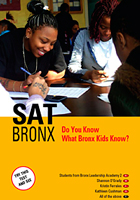March 7, 2013
BRONX, NY — How can you tell if a person is smart? Several years ago, WKCD engaged a group of students at Bronx Leadership Academy 2, a small public high school in New York City, in a yearlong inquiry about intelligence—from the perspective of urban youth. Their inquiry—known as “SAT Bronx”—resulted in a book they wrote and designed with WKCD, along with several multimedia pieces.
The notion that human intelligence could and should be measured, these Bronx students learned, first appeared in the U.S. at the beginning of the 20th century. The psychologists Binet and Simon developed two scales, the Alpha and the Beta, to assess military personnel in World War I. By the 1930’s, the Binet scales had given way to the Wechsler IQ test, which soon spread to schools and other institutions across the country. The “Wechsler” assigned an “intelligence quotient” (IQ) to the test taker, adjusting it for age—while asserting that IQ stays constant over a person’s life span. The Scholastic Aptitude Test (SAT) got its start in 1941, under the College Board.
Still, the Bronx students also learned, there are plenty of researchers and others who question whether intelligence can be summed up in a numerical score. In 1994, 52 scientists signed a proclamation that argued for a new way of looking at intelligence. They defined “intelligence” as a very general mental capability that, among other things, involves the ability to reason, plan, solve problems, think abstractly, comprehend complex ideas, learn quickly and learn from experience. It is not merely book learning, a narrow academic skill, or test-taking smarts. Rather, it reflects a broader and deeper capability for comprehending our surroundings—"catching on," "making sense" of things, or "figuring out" what to do.
As the Bronx Leadership students began their own research they asked, “How can you tell if a person is smart?” They drew distinctions between "book smart" and "street smart." Dinah explains:
“Say we’re in an English class, I would expect the person to use proper grammar and to behave a certain way. When we’re outside, though, you have to act a different way. You have to fit in with the crowd, because if you don’t, then they won’t see you as street smart. They’re going to see you as only book smart. So you have to be smart in many different ways to be completely smart.”
In their small book SAT Bronx: Do You Know What Bronx Kids Know?, written in the form of a standardized test, the students include a section, "What Is Intelligent?"
"This section will test your ability to observe what counts as 'smart' in the world of a Bronx public high school student. First, you will match up students' own descriptions of intelligent behavior with some of the criteria that educators use for assessing intelligence. Next, you will be asked to apply the students' perspectives on intelligence to fictitious scenarios involving behavior in and out of school. As you work, be sure to notice the differeence among the opinions that students express about intelligence. If you do not understand the colloquial language in this section, turn for help to Section I, 'Words You'll Need for the Test.'"
Why don't you sharpen your pencils and see how your ideas about intelligence score with Bronx kids?
What Is Intelligent?




